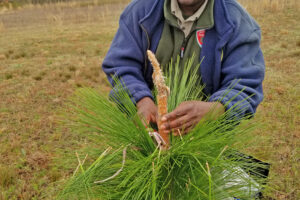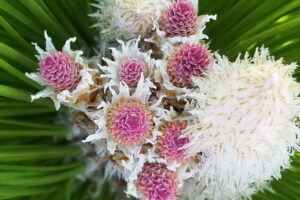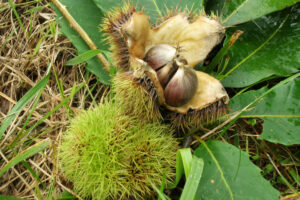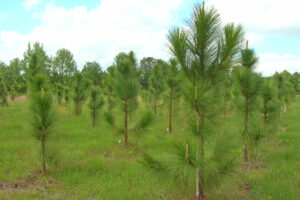 Virginia Department of Forestry Received The American Chestnut Foundation Partnership Award for 2024
Virginia Department of Forestry Received The American Chestnut Foundation Partnership Award for 2024
I offer my sincere congratulations to the Virginia Department of Forestry on winning The American Chestnut Foundation Partnership award for 2024. Your long-standing support and collaborative efforts have laid the foundation for the eventual restoration of American chestnuts to Virginia. We have relied on collaboration with the Virginia Department of Forestry over many years to develop disease resistance, preserve diversity, and continue our chestnut breeding efforts. Thank you for your commitment to chestnut restoration and the preservation of Virginia forests.
Sincerely,
William C. Pitt, PhD, President and CEO
The American Chestnut Foundation
Conservation and restoration of rare or at-risk species is a high-priority for Virginia Department of Forestry. American chestnut was nearly eliminated from our forests over a hundred years ago by an imported fungus. Longleaf pine has declined across its range but in Virginia specifically it has been reduced to a population of just a few hundred remaining mature native trees. And shortleaf pine has declined in occurrence nearly 10-fold in less than a century. DOFconducts research to help reverse these trends. We continue to work in collaboration with the American Chestnut Foundation, Longleaf Alliance, and Shortleaf Initiative on these complex projects.
What Have We Learned
After 40 years of breeding and selection for blight resistance and American chestnut traits, our hybrid chestnut orchards are producing trees that withstand the disease, and we are working with the American Chestnut Foundation to learn the genetic basis for resistance. Our longleaf pine conservation and restoration efforts have enabled us to preserve grafted duplicates of many of our remaining native trees in an orchard that now produces seedlings for restoration efforts in the Commonwealth. And our shortleaf pine work has guided our efforts to successfully re-plant this long-ignored species on the sites where it will be able to thrive.
Ongoing Projects
Our ongoing studies include breeding for blight resistance and identifying re-establishment methods for American chestnut, geographic seed sources and optimum planting densities for longleaf pine, and establishment methods and planting spacing for shortleaf. In addition, our work supports breeding and seed production orchards for all three species.
Additional Resources
| Image | Title | ID | Description | Date | Content Type | View | hf:tax:document-category | hf:tax:Media |
|---|---|---|---|---|---|---|---|---|
 | No. 146 Establishment Methods for Shortleaf Pine | RR-146 | Report provides results from three locations of a study of competition control and fertilizer treatments for establishing shortleaf pine on old-field and cutover sites. Herbaceous weed control (using herbicides or mechanical scalping) at the beginning of the first growing season improved survival and growth of planted shortleaf pine on both old field and cutover sites after two years. | 04/01/2022 | Publication | View | research-resource-information resource-information | publication |
 | No. 147 Establishment Methods for Longleaf Pine | RR-147 | Report provides results from a study of the effects of seedling source (NC orchard mix, GA mountain and GA coastal), competition control methods and planting depth on the establishment and early growth of longleaf pine on an old-field site. Five-year results show that the most important factor in establishment success was scalping. Shallow planting and Oustar at 8 -12 oz./acre were also helpful. | 04/01/2022 | Publication | View | research-resource-information resource-information | publication |
 | America’s Longleaf Restoration Initiative 2020 Range-Wide Accomplishment | DOF is part of the Longleaf Cooperators of Virginia working together to conserve and restore longleaf pine in its native range of southeast United States. Report summarizes the 2020 range-wide accomplishments of America’s Longleaf Restoration Initiative. | 07/01/2021 | Publication | View | forest-management research-resource-information resource-information | publication | |
 | No. 136 Ten-Year Performance of Eight Longleaf Pine Provenances in Virginia | RR-136 | Report provides 10-year results from a study comparing the survival and growth of longleaf pine seedlings from Alabama, Florida, Georgia, Mississippi, North Carolina (two sources), South Carolina, and Virginia. Primarily due to earlier growth initiation and better survival, the Virginia source produced significantly more volume per acre and ranked higher in fitness score than the other provenances. | 11/01/2017 | Publication | View | research-resource-information resource-information | publication |
 | No. 134 Effects of Planting Date (Month) on Longleaf Pine Survival in Virginia | RR-134 | Report provides an update on the effects of planting date on longleaf pine survival in Virginia. | 07/01/2017 | Publication | View | research-resource-information resource-information | publication |
 | From the Brink! The Effort to Restore Virginia’s Native Longleaf Pine – 2014 Status Report | P00212 | Report provides a brief history of longleaf pine in Virginia, the original range of longleaf pine, longleaf and fire, the search for native longleaf pine, the case for conserving and restoring Virginia’s longleaf pine, the importance of Northern-source seedlings for longleaf pine restoration, seed collection and seedling production, orchard development, where we are restoring longleaf pine, special programs available to promote the restoration effort, and future goals and challenges. Printed copies available. | 01/01/2014 | Publication | View | financial-assistance-forest-health forest-health | publication |
 | Forest Research Review 2013-08 | Research reports and updates from ongoing DOF studies. In this issue: fourth cycle loblolly pine tree breeding, spacing impacts on loblolly lumber quality, fertilizer fate and carbon sequestration in loblolly pine, logging slash for skid trail stabilization, longleaf pine provenances, growth and value of low-density loblolly pine plantations, projected value of interplanted loblolly pine, biosolids for fertilizing loblolly pine, growth and value of loblolly pine after site prep vs. release, hardwood plantations in central VA, tree shelters for northern red oak | 08/01/2013 | Publication | View | research-resource-information resource-information | publication | |
 | Forest Research Review 2012-08 | Research reports and updates from ongoing DOF studies. In this issue: effects of pruning in loblolly pine, effects of planting density and fertilizer on loblolly pine growth, varietal vs open-pollinated loblolly pine, biosolids for fertilizing loblolly pine, shortleaf pine provenance test, interplanting loblolly pine, tree shelter comparison for red oak in riparian buffers, crop tree release and fertilization of white oak and southern red oak. | 08/01/2012 | Publication | View | research-resource-information resource-information | publication | |
 | Forest Research Review 2011-05 | Research reports and updates from ongoing DOF studies. In this issue: thinning and fertilization in mid-rotation loblolly pine, loblolly pine planting spacing, biosolids for fertilizing loblolly pine, timing of hardwood control in loblolly pine, longleaf pine provenance comparison, and white oak crop tree release. | 05/01/2011 | Publication | View | research-resource-information resource-information | publication | |
 | Forest Research Review 2010-03 | Research reports and updates from ongoing DOF studies. In this issue: loblolly pine site index, stem sinuosity in loblolly pine, longleaf pine establishment methods, American chestnut, effects of competing hardwoods on loblolly pine, white pine competition control and storage time, tip moth control methods for loblolly pine, white oak crop tree release and fertilization. | 03/01/2010 | Publication | View | research-resource-information resource-information | publication | |
 | Forest Research Review 2009-04 | Research reports and updates from ongoing DOF studies. In this issue: potential for continued loblolly pine tree improvement, effects of thinning and fertilization in loblolly pine, American chestnut breeding program, longleaf pine provenance study, biosolids for fertilizing loblolly pine, interplanting loblolly pine, tip moth control methods for loblolly pine, and southern red oak crop tree release and fertilization. | 04/01/2009 | Publication | View | research-resource-information resource-information | publication | |
 | Forest Research Review 2008-10 | Research reports and updates from ongoing DOF studies. In this issue: loblolly pine seed orchard management strategies, advances in pine plantation silviculture, longleaf pine grafting methods, competition control for shortleaf pine establishment, tip moth control methods for loblolly pine, tree-of-heaven control methods, and northern red oak planting. | 10/01/2008 | Publication | View | research-resource-information resource-information | publication | |
 | Forest Research Review 2008-04 | Research reports and updates from ongoing DOF studies. In this issue: row orientation in loblolly pine growth, fertilizer x planting density effects on loblolly pine growth, varietal vs. open-pollinated loblolly pine, North Carolina and South Carolina families of loblolly pine in VA, longleaf pine establishment methods, longleaf pine provenances, biosolids for fertilizing loblolly pine, interplanting loblolly pine, and southern red oak crop tree release and fertilization. | 04/01/2008 | Publication | View | research-resource-information resource-information | publication | |
 | Preserving Longleaf Pine in Virginia – Restoring Our Native Species | FT0008 | Forestry topic information sheet encourages the preservation of the native species longleaf pine, including the history of longleaf, why preserve longleaf, DOF’s longleaf research, native Virginia longleaf, and cost-share programs available. Printed copies available. | 09/01/2007 | Publication | View | research-resource-information resource-information | publication |
 | Forest Research Review 2007-03 | Research reports and updates from ongoing DOF studies. In this issue: the loblolly pine tree improvement program, competition control for shortleaf pine establishment, competition control for white pine establishment, pruning methods for urban trees, white oak crop tree release, tree-of-heaven control methods, yellow-poplar thinning response, and northern red oak planting. | 03/01/2007 | Publication | View | research-resource-information resource-information | publication | |
 | Forest Research Review 2006-08 | Research reports and updates from ongoing DOF studies. In this issue: longleaf pine establishment methods, shortleaf pine establishment methods, American chestnut backcross breeding, white pine seedling handling and competition control methods, loblolly pine release tank mixes and surfactants, epicormic branching of white oak, and northern red oak planting. | 08/01/2006 | Publication | View | research-resource-information resource-information | publication | |
 | No. 049 Yield of Old Field Shortleaf Pine Plantations; by T. A. Dierauf and J. W. Garner | OR-049 | Report summarizes yield data from 57 shortleaf pine stands in 40 different plantations in 25 different piedmont and mountain counties. | 07/01/1976 | Publication | View | research-resource-information resource-information | publication |
 | No. 028 A Shortleaf and Loblolly Pine Flowering Phenology Study; by R. G. Wasser | OR-028 | Report provides results of a 1967 study to compare flowering dates of the different genetic lines of loblolly and shortleaf pines in the DOF seed orchard at that time. | 12/01/1967 | Publication | View | research-resource-information resource-information | publication |
 | No. 018 Pine Spot Seeding, 1962 Results; by T. A. Dierauf | OR-018 | Report provides first-year results of a study to test spot seeding as a method of establishing loblolly, Virginia and shortleaf pine on cutover land. | 11/01/1963 | Publication | View | research-resource-information resource-information | publication |
 | No. 019 Tree Planting Survival: A 3-Year Study; by R. L. Marler | OR-019 | Report summarizes a three-year study of planting survival of loblolly, shortleaf and white pine, including more than 3,300 different plantings. | 11/01/1963 | Publication | View | research-resource-information resource-information | publication |
 | No. 010 Comparative Growth and Yield of Loblolly and Shortleaf Pine in a Mixed Plantation; W.F. Custard and R. L. Marler | OR-010 | Report provides growth data from a 1937 Buckingham County plantation containing both loblolly and shortleaf pine that was thinned at age 19 and again at age 24, providing evidence of the more rapid growth of loblolly pine. | 10/01/1961 | Publication | View | research-resource-information resource-information | publication |
| No. 001 A Comparison of Tree Growth and Development Between a Shortleaf and Loblolly Pine Plantation Growing on Nason Soil in Orange County, Virginia; by H. W. Bashore and R. L. Marler | OR-001 | Report summarizes field data gathered in Orange County, VA in shortleaf and loblolly pine plantations. | 09/01/1955 | Publication | View | research-resource-information resource-information | publication |
A variety of financial assistance programs are available through DOF and partner agencies for forest management activities.
Explore All Financial Assistance Programs
Contact Us
For more information or questions, e-mail us or use our contact form.




